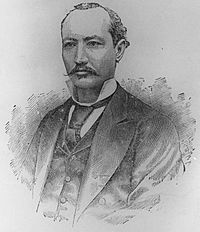Francisco Gregorio Billini facts for kids
Quick facts for kids
Francisco Gregorio Billini
|
|
|---|---|
 |
|
| In office September 1, 1884 – May 16, 1885 |
|
| Vice President | Alejandro Woss y Gil |
| Preceded by | Ulises Heureaux |
| Succeeded by | Alejandro Woss y Gil |
| In office 5 March 1878 – 8 July 1878 |
|
| President | Cesareo Guillermo |
| Preceded by | Juan Isidro Ortea y Kennedy |
| Succeeded by | Casimiro Nemesio de Moya |
| Personal details | |
| Born | May 25, 1844 Santo Domingo, Dominican Republic |
| Died | November 28, 1898 (aged 54) Santo Domingo, Dominican Republic |
| Nationality | Dominican |
| Political party | Blue Party |
Francisco Gregorio Billini Aristi (born May 25, 1844, died November 28, 1898) was an important figure in the Dominican Republic. He was a writer, a teacher, and a politician.
He became the 23rd president of the Dominican Republic. His time as president lasted from September 1, 1884, to May 16, 1885. He decided to step down from office to prevent a civil war. This happened because some people, like Gregorio Luperon, thought he was being controlled by former president Ulises Heureaux. However, Heureaux also opposed Billini when his decisions affected Heureaux's own power.
Contents
Early Life and Family Connections
Francisco Gregorio Billini was born in Santo Domingo. His parents were Maria de Regla Aristi Guerrero and Hipolito Billini Hernandez. His grandfather, Juan Antonio Billini Ruse, came from Piedmont, Italy.
His grandfather arrived on the island in 1802 with French soldiers. These soldiers, led by General Charles Leclerc, came to stop a slave rebellion. This rebellion was happening on the western side of the island, which is now Haiti.
Young Billini went to school in Santo Domingo. He studied at the College of Father Boneau. There, he learned to write in Latin and Italian. He could also speak Italian perfectly, which he learned from his Italian grandfather. Later, he attended the Theological Seminary St. Thomas Aquinas. He was a student of Fernando Arturo de Meriño.
Francisco Gregorio Billini was also the nephew of Francisco Xavier Billini. People in the Dominican Republic knew him as "Padre Billini" (Father Billini). In 1882, Padre Billini started the National Lottery of the Dominican Republic, which still exists today.
Billini's Political Journey
Billini was a member of the Blue Party. He strongly believed that the country should stay independent. At just 21 years old, he joined the Dominican Restoration War. This war ended in 1865. During the war, Spanish troops captured him. He was later exchanged in Puerto Plata as part of a peace agreement.
After the Restoration War, the Dominican Republic faced some difficult political times. This period ended when Buenaventura Baez started his "6-year government." Billini was a strong opponent of Baez's government. He first spoke out against it in publications. Later, he joined an armed rebellion against Baez. Because of this, he was forced to leave the country in 1868.
When he returned, he became a civil servant. He served as a Representative for Azua in 1874. In 1878, he became the Minister of Finance. He was also the Minister of War and Navy in 1880. From March to July 1878, he served as Vice President of the Dominican Republic under President Cesareo Guillermo. He was also the president of the Senate of the Dominican Republic from 1878 to 1879. After these roles, he decided to run for president.
His Time as President
In 1884, Billini ran for president. It was a very close election, but he won against Casimiro Nemesio de Moya. He officially became president on September 1, 1884. However, he resigned less than a year later, on May 16, 1885.
His decision to resign surprised many of his supporters. He explained his choice by saying: "I think it is a good example to be giving my resignation spontaneously and disappearing into the shadows of my house, without petty aspirations for the future."
Other Contributions and Lasting Impact
Before becoming president, Billini started a newspaper called El Eco de la Opinion in March 1879. This newspaper was published for over twenty years. It became known for its thoughtful articles and detailed news. He also wrote regularly for other newspapers like El Nacional and El Patriota.
He published his first novel, Amor y Expiacion, in 1882. But his most important work was the novel Baní or Engracia and Antoñita (1892). This book described the social life and customs of people in the town of Baní during the 1800s.
Francisco Gregorio Billini passed away in Santo Domingo on November 28, 1898. In 1998, his remains were moved to the National Pantheon in Santo Domingo. This was done by order of President Leonel Fernandez. Today, one of the stations of the Santo Domingo Metro is named after him: Francisco Gregorio Billini metro station.
See also
 In Spanish: Francisco Gregorio Billini para niños
In Spanish: Francisco Gregorio Billini para niños

